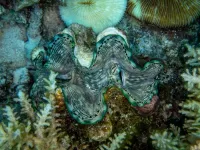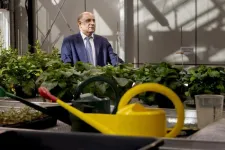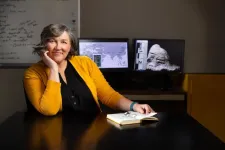(Press-News.org) Giant clams, some of the largest mollusks on Earth, have long fascinated scientists. These impressive creatures can grow up to 4.5 feet in length and weigh over 700 pounds, making them icons of tropical coral reefs.
But these animals don’t bulk up on a high-protein diet. Instead, they rely largely on energy produced by algae living inside them. In a new study led by CU Boulder, scientists sequenced the genome of the most widespread species of giant clam, Tridacna maxima, to reveal how these creatures adapted their genome to coexist with algae.
The findings, published Jan. 4 in the journal Communications Biology, offer clues about how such evolution may have contributed to the giant clam’s size.
“Giant clams are keystone species in many marine habitats,” said Jingchun Li, the paper’s senior author and professor in the Department of Ecology and Evolutionary Biology. “Understanding their genetics and ecology helps us better understand the coral reef ecosystem.”
A symbiotic relationship
Unlike popular myths—like the one in Disney’s “Moana 2” where the giant clam eats humans—these vegetarian mollusks rely on algae living within their bodies for energy. If giant clams ingest the right algae species while swimming through the ocean as larvae, they develop a system of tube-like structures coated with these algae inside their body. These algae can turn sunlight into sugar through photosynthesis, providing nutrients for the clams.
“It’s like the algae are seeds, and a tree grows out of the clam’s stomach,” Li said.
At the same time, the clams shield the algae from the sun’s radiation and give them other essential nutrients. This mutually beneficial relationship is known as photosymbiosis.
“It’s interesting that many of giant clams’ cousin species don’t rely on symbiosis, so we want to know why giant clams are special,” said Li.
In collaboration with researchers at the University of Guam and the Western Australian Museum, the team compared the genes of T. maxima with closely related species — such as the common cockle—that lack symbiotic partners. The researchers found that T. maxima have evolved more genes coded for sensors to distinguish friendly algae from harmful bacteria and viruses. At the same time, T. maxima tuned down some of its immune genes in a way that likely helps the animal tolerate algae living in their body long term, according to Ruiqi Li, the paper’s first author and postdoctoral researcher at the CU Museum of Natural History.
As a result of the clam’s weakened immune system, its genome contains a large number of transposable elements, which are bits of genetic material left behind by ancient viruses.
“These aspects highlight the tradeoffs of symbiosis. The host has to accommodate a suppressed immune system and potentially more viral genome invasions,” said Ruiqi Li.
The study also discovered that giant clams have fewer genes related to body weight control, known as the CTRP genes. Having fewer CTRP genes might have allowed giant clams to grow larger.
Conservation concerns
Last year, a giant clam population assessment by Ruiqi Li, prompted the International Union for Conservation of Nature (IUCN) to update the conservation status of multiple giant clam species. Tridacna gigas, the largest and most well-known species, is now recognized as “critically endangered,” the highest level before a species becomes extinct in the wild.
T. maxima, because of its wide distribution, is currently classified as “least concern.” But Ruiqi Li said it’s possible that different species are lumped into one category simply because they look similar.
“If you think these giant clams are all the same species, you might underestimate the threat they face,” Ruiqi Li said. “Genetic studies like this can help us distinguish between species and assess their true conservation needs.”
The team hopes to sequence the genomes of all 12 known species of giant clams to better understand their diversity.
Similar to corals, giant clams are facing increasing threats from climate change. When the ocean water becomes too warm, the clams expel the symbiotic algae from their tissues. Without the algae, the giant clams can starve.
“The giant clams are very important for the stability of the marine ecosystem and support biodiversity,” Jingchun Li said. She added that many creatures living in the shallow waters rely on their shells for shelter, and giant clams also provide food for other organisms.
“Protecting them is essential for the health of coral reefs and the marine life that depends on them.”
END
How tiny algae shaped the evolution of giant clams
2025-01-27
ELSE PRESS RELEASES FROM THIS DATE:
Men and women equally attracted to younger partners, UC Davis study suggests
2025-01-27
Men and women alike are drawn to younger partners, whether or not they realize it. The conclusion came from a University of California, Davis, study of 4,500 blind dates of people seeking a long-term partner.
“After a blind date, participants were slightly more attracted to younger partners, and this trend was equally true for men and women,” said Paul Eastwick, UC Davis professor of psychology and lead author on the study, published in the journal Proceedings of the National Academy ...
Scientists at UMass Amherst engineer plant-based method of 'precious' mineral mining
2025-01-27
January 27, 2025
Scientists at UMass Amherst Engineer Plant-based method of Precious Mineral Mining
Their research manipulates the superplant Camelina sativa to accumulate nickel, provide oil for biofuel and clean contaminated soil
AMHERST, Mass. — As unassuming plant—considered a noxious weed by some—may be the key to fueling a green economy in the U.S. University of Massachusetts Amherst scientists are working with Camelina sativa, a member of the mustard family, to enhance a trio of the plant’s superpowers: absorbing ...
Hominin presence in Eurasia dated to almost 2 million years ago
2025-01-27
The subject of when early hominins, closely related ancestors to humans, first left Africa to begin their slow dispersal across the globe is a matter of ongoing discussion among anthropologists. The general consensus has been that hominins were present in Eurasia at least 1.8 million years ago, but some ephemeral traces of hominins have hinted at an earlier presence. New evidence by an international team of researchers now pushes that date back to almost 2 million years ago.
This evidence for hominins in Eurasia earlier than ...
Researchers uncover new approach to predict pain sensitivity
2025-01-27
In an international effort, researchers at Western University, the University of Maryland School of Dentistry (UMSOD) and Neuroscience Research Australia (NeuRA) uncovered how specific patterns in brain activity can predict an individual’s sensitivity to pain, expanding opportunities for improved pain management strategies.
The new study was published Jan. 27 in JAMA Neurology. It found the combination of two biomarkers in the brain – corticomotor excitability (CME), excitability in the region of the brain that controls movement, and peak alpha frequency (PAF), a neural marker associated with cognitive performance – can accurately and reliably distinguish high- ...
‘Embodied energy’ powers modular worm, jellyfish robots
2025-01-27
ITHACA, N.Y. – In the same way that terrestrial life evolved from ocean swimmers to land walkers, soft robots are progressing, too, thanks to recent Cornell University research in battery development and design.
A modular worm robot and jellyfish demonstrate the benefits of “embodied energy” – an approach that incorporates power sources into the body of a machine, to reduce its weight and cost.
The worm and jellyfish are direct descendants of an aqueous soft robot, inspired by a lionfish and unveiled in 2019, that could store energy and power its applications via a circulating hydraulic fluid – i.e., “robot blood.” Similar blood sustains ...
Hebrew SeniorLife’s Deanna and Sidney Wolk Center for Memory Health recognized as an age-friendly health system
2025-01-27
Hebrew SeniorLife, New England’s largest nonprofit provider of senior health care and living communities and the only senior care organization affiliated with Harvard Medical School, announces that its Deanna and Sidney Wolk Center for Memory Health has been recognized by the Institute of Healthcare Improvement (IHI) as an Age-Friendly Health System, level 2, Committed to Care Excellence.
To qualify as an Age-Friendly Health System, level 2, the Wolk Center, which provides comprehensive outpatient care related to brain health, cognitive and behavioral problems, and memory loss, whether due to Alzheimer’s disease, other dementias, or other neurological or psychiatric ...
Scientists develop ultra-thin absorbers with record-breaking bandwidth
2025-01-27
Absorbing layers have been fundamental to advancements in technologies like energy harvesting, stealth systems, and communication networks. These absorbers efficiently capture electromagnetic waves across broad frequency ranges, enabling the development of sustainable, self-powered devices such as remote sensors and internet of things (IoT) systems. In addition to energy applications, these layers are pivotal in stealth technology, where they minimize radar visibility and enhance the performance of aircraft and naval systems. They also play a crucial role in improving communication networks by reducing ...
Floating solar increases greenhouse gas emissions on small ponds
2025-01-27
ITHACA, N.Y. – While floating solar – the emerging practice of putting solar panels on bodies of water – is promising in its efficiency and its potential to spare agricultural and conservation lands, a new experiment finds environmental trade-offs.
In the first manipulative field study examining the environmental impacts of floating solar, published in Environmental Science and Technology, researchers found that floating solar panels increased greenhouse gas emissions on small ponds by nearly 27%.
“There ...
Cancer risk established before birth
2025-01-27
GRAND RAPIDS, Mich. (Jan. 27, 2025) — A person’s lifetime risk for cancer may begin before they are even born, reports a paradigm-shifting study by Van Andel Institute scientists.
The findings, published in Nature Cancer, identified two distinct epigenetic states that arise during development and are linked to cancer risk. One of these states is associated with a lower lifetime risk while the other is associated with a higher lifetime risk.
If cancer does develop in the lower risk state, it ...
Sinking truths: University of Houston confirms Miami’s coastal subsidence challenges
2025-01-27
On the barrier islands of Miami, 35 skyscrapers – including Trump Tower III - have sunk as much as eight centimeters, or three inches, into the ground since 2016, and researchers from the University of Houston have played a pivotal role in uncovering the reason why – urban development.
The findings, published in Earth and Space Science, reveal alarming rates of subsidence – or land sinking – in coastal structures between 2016 and 2023.
According to the report, "About half of the subsiding structures are younger than 2014 and at the majority of them subsidence decays with ...






